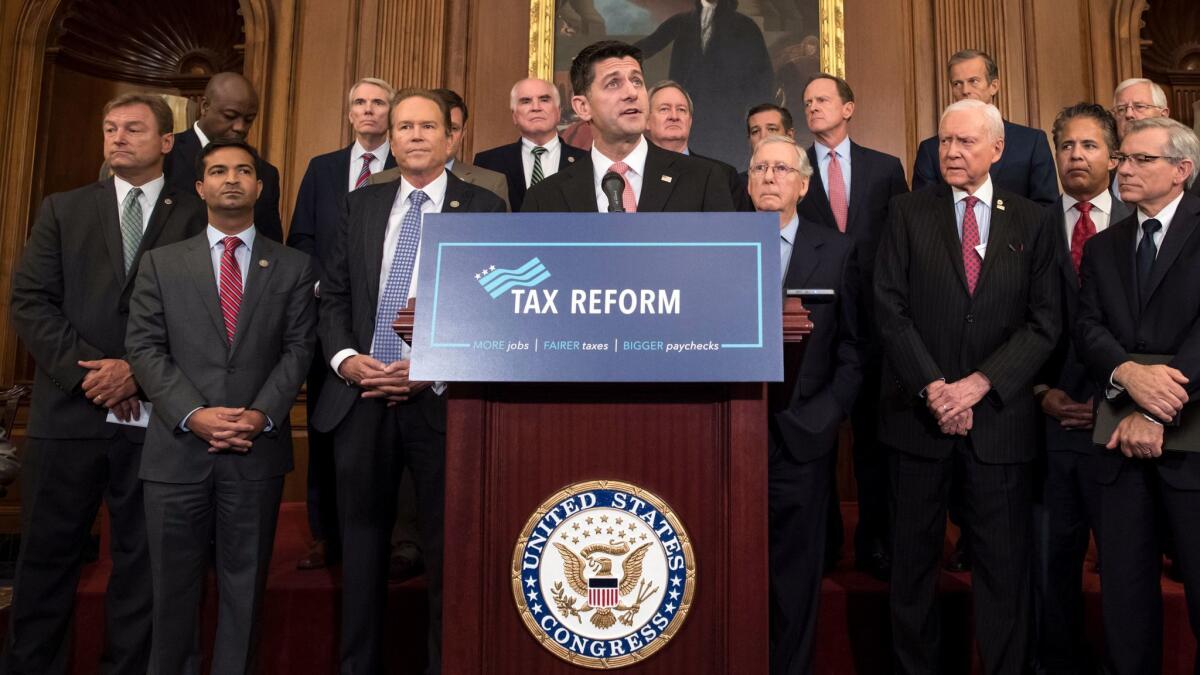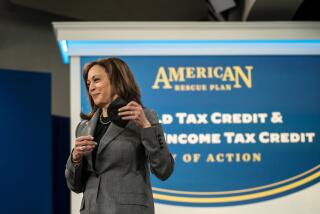Column: Here’s how we know the Republican plea for tax ‘simplification’ is hogwash

- Share via
Ever alert to the possibilities of misleading branding, President Trump and his Republican partners have more or less put the rhetoric of “tax cuts” and “tax reform” on the back burner and bathed their new tax plan in the mantra of “tax simplification.”
Variations of the term appear no fewer than nine times in the eight pages of text in the tax “framework” issued Wednesday by the GOP. The plan offers “the simplicity of ‘postcard’ tax filing.” It’s about “tax relief and simplification for American families.” The framework “simplifies the tax code.” It’s a “simpler and fairer system.” You get the drift.
This is, of course, balderdash. To begin with, the framework contemplates a system so complicated that it punts most of the details to Congress. “It’s not a tax reform plan at all,” observes Edward Kleinbard, the tax expert at the USC law school. “It is a sketch of an outline of a preliminary notion of a tax cut for some — and a tax hike for others.”
More to the point, despite their devotion to the term, it’s crystal clear that “simplification” is a goal that Republicans would run from like villagers fleeting King Kong.
How do we know this? Consider a simple test. The simplest tax system conceivable would be something like this: All earnings below, say, $1 million are taxed at 0%. All earnings higher than that are taxed at 100%. You can insert your own threshold, but whatever it is, even billionaires could file their taxes on a postcard!
It’s not a tax reform plan at all. It is a sketch of an outline of a preliminary notion of a tax cut for some — and a tax hike for others.
— Edward Kleinbard, USC
What are the chances this would pass? Sorry, trick question. Everyone knows the chances are nil.
To be absolutely fair, the “tax simplification” pitch is not new. Republican tax cutters have waved it around for decades as bait to trap the unwary. In the 1990s, the pitch was tied to a “flat tax” — one tax rate for all income and, yes, a postcard-sized tax return. The truth is that even the “flat tax” promoted by short-term presidential candidates like Steve Forbes was not really flat, as Herb Stein, the former economic advisor to Richard Nixon, explained in the Wall Street Journal: Since every flat tax plan included a zero-percent exemption for lower income people, every such plan was actually a progressive system in disguise, though with much less progressivity than the existing system.
Stein in that same piece penned what to me remains the single smartest observation ever made about the American tax system: Whatever the existing degree of progressivity, “people who pay the top rate will think it is too much.”
That’s especially pertinent to the new “framework.” It’s not really about simplifying the tax code, but only about reducing the progressivity of the tax system. Instead to seven brackets with marginal rates ranging from 10% to 39.6%, it would have three, with rates ranging from 12% to 35%.
The framework asserts that by roughly doubling the standard deduction to $24,000 for a couple, it would ensure that lower-income taxpayers get a break even with the higher 12% marginal rate, but Kleinbard casts doubt on that claim. “The larger standard deduction, the unspecified larger child tax credit, and ‘additional tax relief’ to be named later will protect ‘typical’ low-income families from a tax hike, we are told, but others will see their bills actually climb. And the aged and the elderly will lose their additional standard deduction, which under current law offers them up to $5,000 in additional deductions.”
As for the doubled standard deduction, Kleinbard notices that it will be tied to the elimination of the personal exemption, which is worth $4,050 for each family member. “This means that a family of four will go from $28,900 in these deductions (standard deduction plus four personal exemptions) to $24,000 (larger standard deduction but no personal exemptions). That’s a decrease, not a doubling.”
What the tax drafters fail to acknowledge, moreover, is that millions of Americans already can do their taxes on the equivalent of a postcard. It’s Form 1040EZ, which can be used by anyone earning mostly wage income reported on form W-2 from an employer and no more than minimal interest income. The form has essentially three lines for income and one for taxes paid (also reported on the W-2), and then one checks a table to see if a refund is due. As Matt Yglesias observed recently, the only reason the 1040EZ doesn’t fit on a postcard is that it needs space for your name, address, Social Security number, and signature.
The dirty little secret of tax legislating is that no one wants a “simple” tax system, with good reason. The tax system is often the most effective and efficient means of achieving government goals, whether it’s funneling financial assistance to the poor, incentivizing philanthropy (including donations for flood relief down South and in Puerto Rico), or encouraging investments in some industries and the departure of others. Every such goal requires its own provision in the tax code, and since American society and the economy are complicated, so is the code.
One will sometimes hear that it’s improper or immoral to use the tax code to achieve social goals, but the only answer to that is: Sez who? Conservatives and liberals, businesses and individuals, the rich, the poor and the middle class all see the tax code as a saddle for their hobby horses, and the latest “framework” is no exception. The social goal it’s designed to promote is more money for the wealthy (they’re the people who would get a big tax cut), and all this talk about “simplification” is just another way to hide what they’re really up to.
Keep up to date with Michael Hiltzik. Follow @hiltzikm on Twitter, see his Facebook page, or email [email protected].
Return to Michael Hiltzik’s blog.
More to Read
Inside the business of entertainment
The Wide Shot brings you news, analysis and insights on everything from streaming wars to production — and what it all means for the future.
You may occasionally receive promotional content from the Los Angeles Times.











